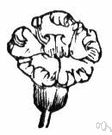A Chinese herbal dating from the 16 th century suggests Star Anise will cure lower back pain and if used in conjunction with fennel (
Foeniculum vulgare), will remedy hernias of the intestines and bladder.
They are a synergistic mixture of the extract from best quality dry leaves of organic rosemary (Rosmarinus officinalis), combined with the organic volatile oil steam-distilled from the best quality dried fruits of fennel (
Foeniculum vulgare).
Among some representatives species of the Apiaceae family, we can mention; the Cuminum cyminum (cumin), Anethum graveolens (dill), Pimpinella anisum (anise) and
Foeniculum vulgare (fennel) and the fennel (
Foeniculum vulgare), plants with culinary and medical applications (Downie et al., 2000).
Bailey,
Foeniculum vulgare Mill., Ocimum basilicum L., Ocimum gratissimum L., and Piper hispidinervum C.
Among all respondents, the most commonly used herbal medicines were black seed (Nigella sativa) (20%), anise (Pimpinella anisum) (13%), olibanum (Boswellia sacra) (12%), ginger (Zingiber officinale) (11%), fennel (
Foeniculum vulgare) (10%), guava (Psidium guajava) leaf (10%), olive (Olea europaea) oil (9%), thyme (Thymus vulgaris) (6%), chamomile (Matricaria chamomilla) (5%), peppermint (Menthapiperita) (5%), clove (Syzygium aromaticum) (5%), turmeric (Curcuma longa) (4%), costus (Saussurea lappa) (4%), sidr (Ziziphus spina-christi) (3%), myrrh (Commiphora myrrha) (3%), Ivy (Hedera helix) (3%), sesame (Sesamum indicum) oil (3%).
Samples of rosemary powder, common fennel (
Foeniculum vulgare) powder, lemon myrtle (Backhousia citriodora) powder, basil leaves (Ocimum basilicum), wild thyme (Thymus serpyllum) leaves, garden sage leaves, and summer savory leaves were bought from Harissa spice store, Armina Srapca 8,10000 Zagreb, Croatia, and all samples have EU origin; laurel powder and garden sage powder were bought from Farma shop, Meduliceva 18, Zagreb, EU origin; nettle leaves (Urtica dioica) and lemon grass (Cymbopogon citratus) were obtained from Suban d.o.o., 10434 Strmec, Croatia.
[40] for fennel seed (
Foeniculum vulgare) which were between 7.78% to 21.67% db.
Bioactivity,
Foeniculum vulgare, GC-MS, Ocimum basilicum, Heterotermes indicola.
Pharmacological evidence of hypotensive activity of Marrubium vulgare and
Foeniculum vulgare in sponta-neously hypertensive rat.
Vitis vinifera,
Foeniculum vulgare Name of the Warnings (According to literature Preparation and/or Monographs) Sambucol [R] * Due to the insufficient data Sambucus nigra L.
A field experiment was carried out at at College Agronomy Farm, Anand Agricultural University, Anand during rabi 2016-17 to study the influence of integrated nutrient management practices on yield, quality and nutrient status of drilled rabi fennel (
Foeniculum vulgare Mill) on sandy loam type of soils having slightly alkaline pH (8.1), low organic carbon (0.49%) and available nitrogen (230.50 kg N [ha.sup.-1]), medium available phosphorus (39.56 kg [P.sub.2][O.sub.5] [ha.sup.-1]) and high available potash (315.40 kg [K.sub.2]O [ha.sup.-1]).
(2014) reported that the increase of concentration and treatment time with fennel seed EOs (
Foeniculum vulgare Mill.) resulted in a proportional increase of the cell membrane permeability of Shigella dysenteriae, causing the release of intracellular compounds, especially potassium, calcium, and sodium ions.
 Foeniculum vulgare - strongly aromatic with a smell of aniseed; leaves and seeds used for seasoning
Foeniculum vulgare - strongly aromatic with a smell of aniseed; leaves and seeds used for seasoning